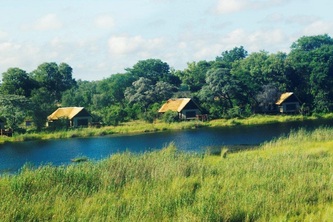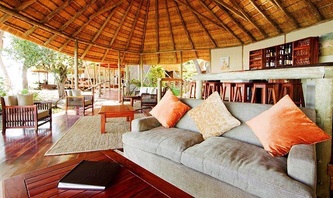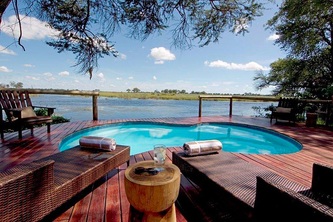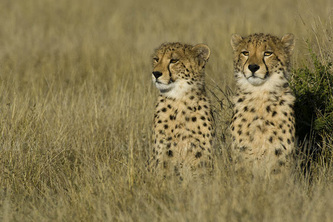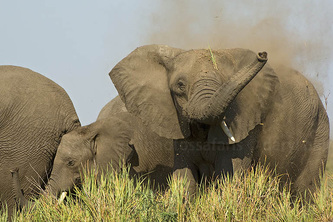DESERT thru DELTA - The Best of Botswana?
April-May 2025

Lounge at Nxai Pan Camp, Nxai Pan NP.
Join us on our Desert thru Delta Wildphotos Safari with Daryl Balfour in April-May 2025, late autumn in the southern hemisphere, as we explore the diversity of Botswana’s desert & delta landscapes. Traveling from the safari capital of Maun via the exciting salt-pans of Nxai Pan National Park to the heart of the great Central Kalahari Game Reserve and then through the permanent waterways of the spectacular Okavango Delta to the sandveld and woodland along the meandering Kwando River in the country’s remote north-east, this safari could quite easily be called the “Best of Botswana.”
Starting from the small town of Maun, the safari capital of southern Africa, we will take a charter flight shortly after our arrival heading south-east to Nxai Pan for two nights at Nxai Pan camp. Here we can expect to see predators such as lion and cheetah and also ghostly white elephants cloaked with the white calcrete dust of this area. While at Nxai Pan we could decide to visit the famous Baines' Baobabs nearby, depending upon the action around the pan each day. After two nights at Nxai Pan our chartered flight wioll carry us further south into the heart of the Central Kalahari Game Reserve to Tau Camp, situated on the very dune edge overlooking Tau (lion) Pan. Accommodation is in custom-designed suite-tents set under thatch.
The Central Kalahari was made famous by the book Cry of the Kalahari by Mark & Delia Owens back in the early Eighties, and for years has been one of the least explored areas of the Kalahari. Tau Camp is the first semi-permanent camp to be built in the central Kalahari and has been designed with the latest eco-sensitive principles in mind.
Game in the Central Kalahari ranges from the big cats such as the famed black-maned Kalahari lions, cheetah and leopard, with antelope species such as springbok, gemsbok (oryx) and red hartebeest one is unlikely to see in other parts of Botswana. Kalahari desert specials such as brown hyaena, honey badger, porcupine and meerkats are also possibly to be seen. Other activities include the possibility of taking a guided walk in the company of a Bushman (San) tracker
Starting from the small town of Maun, the safari capital of southern Africa, we will take a charter flight shortly after our arrival heading south-east to Nxai Pan for two nights at Nxai Pan camp. Here we can expect to see predators such as lion and cheetah and also ghostly white elephants cloaked with the white calcrete dust of this area. While at Nxai Pan we could decide to visit the famous Baines' Baobabs nearby, depending upon the action around the pan each day. After two nights at Nxai Pan our chartered flight wioll carry us further south into the heart of the Central Kalahari Game Reserve to Tau Camp, situated on the very dune edge overlooking Tau (lion) Pan. Accommodation is in custom-designed suite-tents set under thatch.
The Central Kalahari was made famous by the book Cry of the Kalahari by Mark & Delia Owens back in the early Eighties, and for years has been one of the least explored areas of the Kalahari. Tau Camp is the first semi-permanent camp to be built in the central Kalahari and has been designed with the latest eco-sensitive principles in mind.
Game in the Central Kalahari ranges from the big cats such as the famed black-maned Kalahari lions, cheetah and leopard, with antelope species such as springbok, gemsbok (oryx) and red hartebeest one is unlikely to see in other parts of Botswana. Kalahari desert specials such as brown hyaena, honey badger, porcupine and meerkats are also possibly to be seen. Other activities include the possibility of taking a guided walk in the company of a Bushman (San) tracker

Six of the Magnificent Seven, Kwara.
After our three nights in the Kalahari we make a complete change of environment, flying north over the watery wonderland of the Okavango Delta, one of the greatest wetlands in the world. We spend three nights at the small and intimate Little Kwara or Splash safari camp, situated on the very edge of the permanent waters of the Delta and the Moremi Game Reserve. By early April the annual flood could be filtering into the surrounding floodplains, bringing with it a myriad birds and attracting thirsty animals to its soothing waters. The Kwara private concession has gained acclaim in recent years for its predator population, with its adult male lions (right) being most spectacular. The area is also renowned for its cheetah, leopard and hyaena sightings, while wild dogs also occur here on a regular basis. Kwara camp is also set on permanent major waterways of the Okavango Delta and we will have opportunities to explore the backwaters by dug-out canoe (mokoro) and the major lagoons by double-decker powerboat for excellent bird viewing & photography.

Wild dog reflection, Lagoon Camp.
From Little Kwara or Splash we once again fly north-east, to Botswana’s very borders with Namibia’s Caprivi Strip, the Kwando Private Game Reserve, where we spend three nights at the newly renovated Lagoon Camp. A personal favourite, Lagoon Camp is named for the tranquil lagoon in a backwater of the Kwando River it overlooks. The Kwando continues downstream to become the Chobe, which later joins the Zambezi.
Lagoon Camp is world famous for its predators, particularly wild dogs (left) but also lion, leopard and cheetah. The Kwando concession area is also known for its elephants as well as the rarer roan and sable antelopes and we will hope to find these on our daily drives. Here we will also take the opportunity to conduct night drives with powerful spotlights, seeking the more unusual nocturnal species such as genet, porcupine, pangolin and aardwolf. For those uncertain of their night photography skills, Daryl Balfour will be on hand with personal tutoring and will ensure you have any special equipment required beforehand if you so desire.
Lagoon Camp was totally rebuilt at the beginning of 2011. (Click on the images below to enlarge and see captions)
Lagoon Camp is world famous for its predators, particularly wild dogs (left) but also lion, leopard and cheetah. The Kwando concession area is also known for its elephants as well as the rarer roan and sable antelopes and we will hope to find these on our daily drives. Here we will also take the opportunity to conduct night drives with powerful spotlights, seeking the more unusual nocturnal species such as genet, porcupine, pangolin and aardwolf. For those uncertain of their night photography skills, Daryl Balfour will be on hand with personal tutoring and will ensure you have any special equipment required beforehand if you so desire.
Lagoon Camp was totally rebuilt at the beginning of 2011. (Click on the images below to enlarge and see captions)
This safari is for four persons only and we can accommodate one couple and two singles if necessary. Private sole-use vehicles have been reserved at all camps for our Wildphotos Safaris group, while an extra two seats have been booked on all air charters to allow each guest double the normal luggage limit to cater for camera gear.
The safari will run in April-May 2025 from Maun, Botswana. Please contact us if you would like us to make Air Botswana or SA Airlink bookings on your behalf for the flights from Johannesburg to Maun and back.
Please Enquire HERE for rates & dates.
This safari is likely to be extremely popular and we have space for only four people, including two singles. To book your place contact us HERE now.
The safari will run in April-May 2025 from Maun, Botswana. Please contact us if you would like us to make Air Botswana or SA Airlink bookings on your behalf for the flights from Johannesburg to Maun and back.
Please Enquire HERE for rates & dates.
This safari is likely to be extremely popular and we have space for only four people, including two singles. To book your place contact us HERE now.
